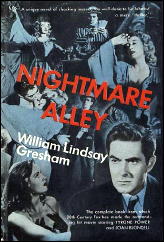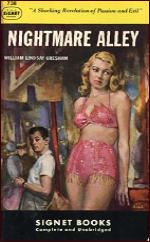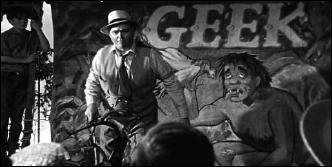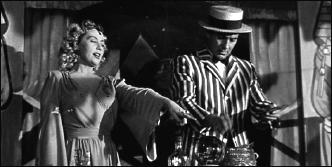Wed 10 Oct 2012
Reviewed by Dan Stumpf (Book/Film): NIGHTMARE ALLEY (1946/1947).
Posted by Steve under Films: Drama/Romance , Reviews[7] Comments

WILLIAM LINDSAY GRESHAM – Nightmare Alley. Rinehart & Co., hardcover, 1946. Triangle Books, hardcover, Photoplay edition, 1948. Signet #738, paperback, 1949. Popular Library, paperback, 1976. Carroll & Graf, paperback, 1986. New York Review of Books, softcover, 2010. Included in Crime Novels: American Noir of the 1930s and 40s, Library of America, hardcover, 1997.
NIGHTMARE ALLEY. 20th Century Fox, 1947. Tyrone Power, Joan Blondell, Coleen Gray, Helen Walker, Taylor Holmes, Mike Mazurki, Ian Keith. Based on the novel by William Lindsay Graham. Director: Edmund Goulding.
The very words “nightmare alley” with their fusion of dreams and squalor, phantasm and filth, promise a lot when you put them on a book. Or a movie. Nowadays it’s possible to read a book and watch the film made from it in close proximity, and a while back I had a bit of ghoulish fun with the exercise.

Nightmare Alley was William Lindsay Gresham’s first novel, and though there’s a bit of fat in the book, it’s still a powerful and often unsettling tale of Stan Carlisle, a smooth carnival huckster who promotes himself to spiritualist and then religious con-man, rising in society only to find that the seeds of his own undoing were always within him and “what we saw and he didn’t†have grown to hideous (nightmarish?) proportions.
This was the work that brought the term geek to the public, and Gresham’s description of just what a geek was in those days, and how one was made, is still chilling today. It ain’t for every taste, but fans of Jim Thompson and David Goodis will find it a rare and — in its own way — unforgettable treat.
(PARENTHETICAL NOTE: William Lindsay Gresham (1909-1962) was, from all accounts, an alcoholic who abused his wife and children and ended up a suicide. His treatment of his wife and kids was bad enough that his spouse took the children and fled to England — where she met, fell in love with, and married C. S. Lewis. Their story can be seen in the film Shadowlands.)

The movie Nightmare Alley that came out in 1947 is something of a surprise from a major studio like Fox, a “class” director like Edmund (Grand Hotel) Goulding, and producer George Jessell (!) but it’s slick, savage, seedy and immensely satisfying.
Tyrone Power — a smooth leading man with an odd flair for self-destructive roles — puts bitter bite into his performance as Carlisle, ably supported by a spirited cast of capable players, including Joan Blondell, Ian Keith, Mike Mazurki, and chilling Helen Walker as a lethal psychologist; the scene where she destroys Power’s psyche is worthy of Lady MacBeth.

Lee Garmes’ evocative, sleazy-splendid photography helps out too, but best of all is Jules Furthman’s cunning screenplay. Undulating past the censors, he takes the masochism explicit in the book and makes it implicit in the character, and even hints at a darker ending than the one we see on screen.
Furthman always was a good hand at adapting the works of others (To Have and Have Not, The Big Sleep, etc.) with a slick trick of slicing just enough out of a book to get past the censors, while still preserving the tone of the piece, and his work here is simply splendid.
https://www.youtube.com/watch?v=idlYaKQ1yjw
October 10th, 2012 at 11:46 pm
I’ve read this book twice and watched the film version after each reading. I also was impressed by both the book and film adaptation. A great novel and and a great film noir. I highly recommend both versions but for the most fun, read the book first and then watch the movie.
October 11th, 2012 at 7:09 am
(SPOILER HERE) What impressed me about Furthman’s screenplay is that he was obviously forced to tack on a happy ending, but he subverted it. At the end of the picture, Tyrone Power is in the same role Ian Keith was at the beginning: a broken drunk who knows of a valuable con-code, but is now too far gone to use it, and gets along in the carny supported by his loving woman. This is brought out by Furthman’s addition of the fortune-telling scenes: first where Keith reads Power’s mind, and later where Power uses the same corny technique on a bunch of bums, the two scenes making a sort of narrative metaphor linking Power’s fate to Keith’s.
October 11th, 2012 at 10:33 am
A very good review. I have two copies of the SIGNET edition, but I have not yet read the novel. More information about Gresham one can find in: Paul Duncan: Noir Fiction, Pocket Essential 2000.
October 11th, 2012 at 8:19 pm
This book was recommended to me very early on in my intro to hardboiled fiction. I thought it was a terrific read and enjoyed the movie just as much.
The movie follows the book completely as far as I remember. Josef, I suggest you grab the lesser condition SIgnet pb and after ogling the great cover art, read it. You won’t be sorry.
October 22nd, 2012 at 11:08 am
Excellent book and movie. Didn’t care for the ending of the movie, the one in the book was more consistent with the plot. Supposedly, this was Anton LaVey’s favorite movie.
December 11th, 2012 at 2:21 pm
If it hasn’t been mentioned before, William Lindsay Gresham was a member of the Abraham Lincoln Brigade, the so-called communists who volunteered to fight aganst the Franco
regime in Spain, 1936-1939, when Francisco Franco and his colleagues took over the duly
elected democratic party in Spain. Franco’s allies were Adolf Hitler and Benito Mussolini, both of whom sent troops to aid
him.
February 7th, 2015 at 4:04 pm
Both the book and the film were excellent, despite the film’s somewhat happy ending. As for this being Anton S. LaVey’s favorite movie it also was his favorite book (along with the King In Yellow by Robert W. Chambers)and it played a huge part in the creation of his public persona (legend?) and the haphazard religion he founded. LaVey’s life, more or less, followed that of the fictional character of Stan Carlisle in Nightmare Alley. Neither one’s life ended well – then again neither did the author’s life to come think of it.